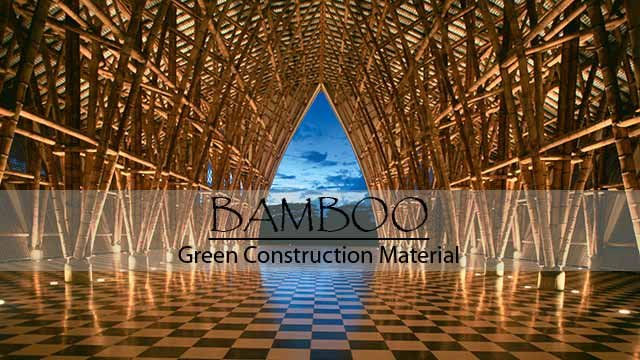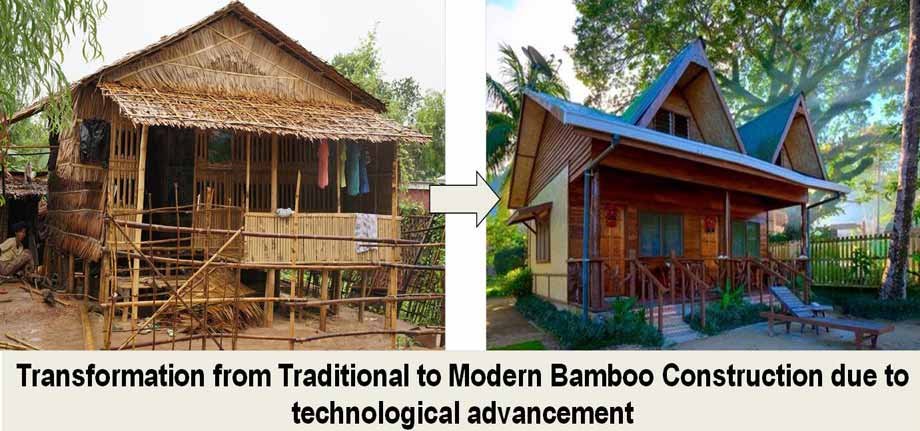
Bamboo: A potential Green Construction Material
Bamboo is owned by the grass family and has been related with various titles such as “poor man’s timber”, “Green Gold” etc. because of its various registered applications. It is widely recognized as highly renewable, fast growing, economic raw material.
India has the huge prospective for bamboo with approximate 14 million hectares of bamboo forest area (majorly in north eastern part of India). India is the second largest country in terms of bamboo resources and wealth. The production of bamboo in India is very less compared to Japan, Taiwan and China which contribute about 80-85% to the world’s bamboo market (reference 1).
 In coming future, India is expected to face huge timber scarcity in order to meet the housing needs of the fast growing population. Moreover, the increased dependence on standard / conventional materials is held accountable for degradation of environment. Both the reasons have led to give a thought on the use of bamboo as a replacement for wood and steel as it is contemplate as highly renewable and environment friendly substance.
In coming future, India is expected to face huge timber scarcity in order to meet the housing needs of the fast growing population. Moreover, the increased dependence on standard / conventional materials is held accountable for degradation of environment. Both the reasons have led to give a thought on the use of bamboo as a replacement for wood and steel as it is contemplate as highly renewable and environment friendly substance.
Bamboo products (bamboo veneers, bamboo boards, bamboo mats, corrugated roofing sheets, etc.) due to their physical and mechanical staging in terms of hardness, firmness and power are gaining notice with large opportunities in emerging market. Additionally, bamboo has the ability of reducing / mitigating climate change as it restores degraded area, act as carbon sequesters and safeguards from soil erosion.
Recently developed technologies on bamboo have been evolved which has significantly increased its resistance and quality / grade and opened new areas for bamboo as an effective wood substitute. Traditional bamboo culm (reference 2) used in traditional housing can now be modified into a brand new and innovative bamboo based products with latest technology and can be used in top quality grade houses in roofing, doors, windows, flooring etc.
Presently India has no / less export market for bamboo products except a negligible export of art and handicrafts products. India has huge potential for bamboo export as it is the second largest country after China in terms of bamboo resources and production.
Bamboo sector has been getting help from various promotors that include government sector (central and state), private sector, and research institutes including financial institutes. These promotors are widely promoting and regulating the use of bamboo in construction sector. Few policies set up by central and few state governments for bamboo development has also been responsible in spreading the use of bamboo in construction. National Bamboo Mission (NBM) and National Mission on Bamboo application (NMBA) are playing major role both at central and state level in India.
Despite of these big initiatives bamboo is not being used much in construction sector as maybe there is a huge demand and supply gap for bamboo raw material. Majority of the Indian bamboo is supplied to the paper and pulp industries because of increased paper demand after which very little is left for consumption by other industry like construction sector. In addition, the regulatory mechanisms in India force restriction on transit and harvesting of bamboo which has a negative footprint on the bamboo construction industry.
Bamboo and its Uses –
Worldwide Bamboo has more than 1,500 registered uses, ranging from small toys to fuel-wood, medicines to poison, handicrafts to aircraft manufacturing. The products made from bamboo can be majorly classified into:
- Industrial use products (paper and pulp, bamboo charcoal for fuel, bamboo based gasifier for electricity)
- Food Products (consumption of bamboo shoots)
- Construction and Structural Applications (Bamboo housing)
- Wood Substitutes and Composites (Bamboo based panels, Veneers, Bamboo Flooring, Bamboo Sheets, Bamboo pillow, mat boards, fiber boards, particle boards, medium density boards, combinations of these, and combinations of these with wood and other ligno-cellulose materials and inorganic substances).
- Cottage and Handicraft Industry
Use of Bamboo in Construction –
In construction sector, bamboo is having a huge potential and already in utilization to make all the components of building for both structural and non-structural members. Due to its low cost, traditionally bamboo culms were used for constructing housing in rural areas, scaffolding and for constructing foot bridges over small rivers and drains. For construction Bamboo was less utilized in past but now after technological advancement, can be utilised in different ways for doors, roof structures, windows, walls, ceiling, man-hole covers, reinforcement etc.
Bamboo Construction and Structure Application –
Traditionally, bamboo culms (reference 3) were used as primary building materials for constructing huts or bamboo frame was plastered with portion of cement or clay which has now renamed as the construction of prefabricated bamboo housing. Lot of development has taken place to improve the technology and unique techniques that can be used to make bamboo suitable for reinforcement and construction. There has been improvement in the protection and preservation technology of bamboo as well as in jointing techniques so that the use of bamboo can be perfectly utilized as construction material. These technologies are assisting in increasing the durability of bamboo as a reinforcement and construction material. Advances in structural engineering and the development of bamboo composites have opened new vistas for durable, lightweight, quick and aesthetic construction for a variety of applications with absolute treatment.
Potential for Bamboo construction in India –
India having one of the largest natural reserves of bamboo in the world is dealing with the shortage of bamboo as a raw material in its industries. Presently Bamboo is underutilized and found in abundance. If bamboo in construction sector has to be grown beyond the certain level, the regulatory restrictions on transits and trade need to be taken care off by the government.
Bamboo has ability to play an important role in meeting the future human needs as replacement of timber used as input for housing and construction. In the light of rapidly shooting demand of raw materials for housing and construction sector, including timber and decreasing forest covers, bamboo based construction materials can serve as a perfect alternative in bridging the gap of demand and supply. Amendments in the existing regulations and laws can help in the growth of bamboo based construction sector. Certain States in India like Tripura, Kerala, Madhya Pradesh, etc. have already been doing so.
Governmental organizations can play a vital role for promotion which would help generate public awareness on bamboo products and its benefits. Government can run promotional campaigns and can help in establishing more number of bamboo products and promotional showrooms such as “PURBASHA” in the case of Tripura. It can also uplift private sector to enter into bamboo market as the promotion will help in increasing the awareness among the people about the bamboo use in housing and construction.
References :-
- Bamboo Diversity conservation in India, Sas Biswas (Scientist, Botany Division, Forest Research Institute, Indian Council of Forestry Research & Education, Dehradun, India).
- The woody, hollow aerial stems of bamboo grow in branching clusters from a thick underground stem (rhizome).
- The woody, hollow aerial stems of bamboo grow in branching clusters from a thick underground stem (rhizome).






